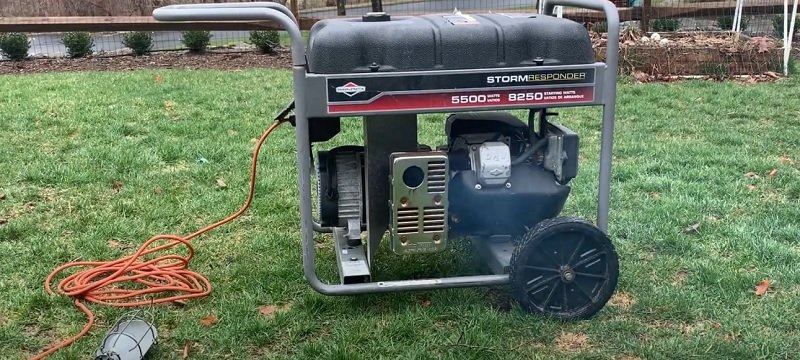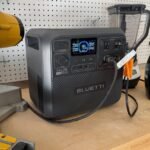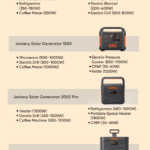Disclosure: This post contains affiliate links and I will be compensated if you make a purchase after clicking through my links. Learn More
If your generator backfires when attempting to start, there may be an issue with the fuel mixture or the ignition timing. This can result in a loud bang and potentially damage the engine.
To troubleshoot, check the carburetor, spark plug, and air filter to ensure they are clean and functioning properly. Additionally, make sure the fuel is fresh and up to the recommended level. If the problem persists, it is advised to seek professional assistance from a qualified technician to prevent further damage and ensure safe operation of the generator.

Understanding Generator Backfires
Generator backfires can be an unexpected and sometimes alarming issue that arises when attempting to start your generator. These backfires occur when the combustion process in the engine is disrupted, resulting in explosions that can be heard as loud pops or bangs. Not only can backfires startle you, but they can also cause damage to your generator if left unchecked.
Causes Of Generator Backfires
There are several common causes for generator backfires. Understanding these causes can help you identify and prevent backfires from occurring. Here are some of the most frequent culprits:
- Fuel Mixture: Incorrect fuel-to-air ratio can cause a backfire. If the mixture is too rich (too much fuel), the excess fuel can ignite in the exhaust system, resulting in a backfire. On the other hand, a lean fuel mixture (too little fuel) can cause backfires as well. Maintaining the correct fuel-to-air ratio is crucial for preventing backfires.
- Ignition Timing: When the ignition timing is off, the spark plugs may fire either too early or too late. This can lead to backfires during the starting process. It is essential to ensure the ignition timing is properly calibrated to prevent this issue.
- Spark Plug Issues: Faulty or worn-out spark plugs can cause backfires. If the spark plug is not igniting the fuel properly, it can lead to an explosion in the exhaust system or back into the intake manifold.
- Air Filter Problems: A clogged or dirty air filter restricts airflow into the engine, which can disrupt the combustion process and cause backfires. Regularly cleaning or replacing the air filter can help prevent this issue.
- Exhaust System Leaks: If there are any leaks in the exhaust system, unburned fuel can escape and create backfires. Inspecting and repairing any exhaust leaks is essential for preventing backfires.
How Backfires Affect The Starting Process
When a generator backfires, it can have a significant impact on the starting process. Here’s how backfires can affect generator starting:
- Interference: Backfires can disrupt the engine’s starting sequence, causing it to stall or fail to start altogether. The force of the explosion can throw the engine’s pistons off balance, making it difficult for them to move smoothly, and hindering the starting process.
- Damages Components: Backfires can damage various components of the generator, such as the exhaust system, intake manifold, and even the engine itself. These explosions can lead to cracked or warped parts, increased wear and tear, and costly repairs. Properly addressing backfires promptly can help prevent extensive damage.
- Safety Concerns: Backfires can be a safety hazard, especially if fuel ignites in the exhaust system. The loud explosions and potential for flames can create dangerous situations. Taking steps to prevent backfires ensures the safety of both you and your generator.
Identifying Common Signs Of Backfiring
Being able to identify common signs of backfiring can help you address the issue promptly. Keep an eye out for these indicators:
Loud Popping Noises: Backfires are often accompanied by loud popping or banging sounds. If you hear these noises during the starting process, it is likely a sign of backfiring.
Flames or Smoke: In severe cases, backfires can result in visible flames or smoke. If you notice any flames or smoke coming from your generator, it is crucial to address the backfiring issue immediately.
Engine Stalling: Backfires can cause the engine to stall or struggle to stay running. If your generator frequently stalls or has difficulty starting, it could be a symptom of backfiring.
Exhaust Odor: If you detect a strong smell of fuel in the exhaust fumes, it may indicate backfiring. The unburned fuel escaping from the exhaust system can create a noticeable odor.
By understanding the causes, effects, and signs of generator backfires, you can take the necessary steps to prevent backfires and ensure your generator starts smoothly every time. Regular maintenance, such as checking the fuel mixture and ignition timing, can go a long way in avoiding this frustrating and potentially damaging issue.
Addressing Fuel Related Issues
When it comes to troubleshooting a generator that backfires during starting, one of the common culprits is fuel-related issues. Proper fuel flow is crucial for the generator to function smoothly. In this section, we will discuss some key steps you can take to address fuel-related issues and get your generator up and running efficiently.
Checking Fuel Quality And Octane Rating
The first step in addressing fuel-related issues is to ensure that you are using fuel of good quality. Poor fuel quality can lead to problems with starting and running your generator. Here are some things you can do to check fuel quality:
- Inspect the fuel for impurities: Using a clean, clear container, take a sample of the fuel and examine it for particles, water, or any other contaminants. If you notice any impurities, it’s advisable to drain the fuel tank and refill it with fresh fuel.
- Check the octane rating: Generators often require fuel with a specific octane rating. Check your generator’s manual to determine the recommended octane rating, and make sure the fuel you are using meets this requirement. Using fuel with the wrong octane rating can cause backfiring and other performance issues.
Cleaning Or Replacing Clogged Fuel Filters
Fuel filters play a vital role in preventing impurities and debris from entering your generator’s fuel system. Over time, these filters can become clogged, impeding fuel flow and causing backfires. If you suspect a clogged fuel filter, you can follow these steps to clean or replace it:
Locate the fuel filter: Consult your generator’s manual to find the fuel filter’s location. It is typically located along the fuel line, between the fuel tank and the carburetor.
Turn off the generator and disconnect the fuel line: Before working on the fuel filter, ensure that the generator is turned off and the fuel line is disconnected to prevent any fuel leakage.
Clean the fuel filter: If the fuel filter is reusable, remove it and clean it with a suitable solvent, such as carburetor cleaner. Gently scrub away any residue or debris, and then rinse it thoroughly with clean fuel. Allow the filter to dry completely before reinstalling it.
Replace the filter (if necessary): If the fuel filter is not reusable or cleaning did not resolve the issue, it is recommended to replace the filter with a new one. Ensure that you use the correct filter size and type as specified in your generator’s manual.
Reconnect the fuel line and start the generator: Once the fuel filter is clean or replaced, reconnect the fuel line securely and start the generator to see if the backfiring issue is resolved.
Adjusting The Fuel-to-air Ratio
Another fuel-related issue that can cause backfires is an imbalanced fuel-to-air ratio. If the mixture is too rich or too lean, your generator may struggle to start and emit backfires. Follow these steps to adjust the fuel-to-air ratio:
Locate the carburetor: Refer to your generator’s manual to find the carburetor’s location. The carburetor is responsible for blending fuel and air to create the optimal mixture for combustion.
Identify the adjustment screws: On the carburetor, you will find two screws labeled “H” and “L.” The “H” screw controls the high-speed fuel mixture, while the “L” screw controls the low-speed fuel mixture.
Start the generator: With the generator running, turn the “H” screw slowly clockwise until the engine begins to run smoother. Then, turn it counterclockwise until the engine starts to run rougher. Find the midpoint where the engine runs at its best.
Adjust the “L” screw: Starting from the midpoint determined for the “H” screw, turn the “L” screw counterclockwise until the engine starts to run rougher. Then, turn it clockwise until it smooths out. Find the midpoint where the engine runs consistently.
Test the generator’s performance: After adjusting the fuel-to-air ratio, test the generator’s performance by starting it and running it under load. Monitor for any backfires or irregularities, and make further adjustments if necessary.
By addressing fuel-related issues such as checking fuel quality and octane rating, cleaning or replacing clogged fuel filters, and adjusting the fuel-to-air ratio, you can significantly improve the starting and running performance of your generator while minimizing backfires.
Resolving Ignition Problems
When it comes to starting your generator, encountering ignition problems can be frustrating and time-consuming. One common issue is when your generator backfires during start-up. This can be caused by various factors, such as faulty spark plugs, incorrect ignition timing, or malfunctioning ignition coils. In this article, we will delve into the steps you can take to resolve these ignition problems and get your generator running smoothly again.
Inspecting And Cleaning Spark Plugs
The spark plug plays a vital role in the ignition process of your generator. Over time, it can become fouled with carbon deposits, affecting its performance. To resolve this issue, follow these steps:
- Switch off the generator and let it cool down.
- Locate the spark plug, usually found on the side of the engine.
- Remove the spark plug using a spark plug socket and extension.
- Inspect the spark plug for signs of wear and carbon buildup.
- If the spark plug appears dirty, use a wire brush or spark plug cleaner to remove any carbon deposits.
- Check the spark plug gap using a feeler gauge and adjust it if necessary.
- Reinstall the spark plug, ensuring it is tightened securely.
By inspecting and cleaning your spark plugs regularly, you can prevent ignition problems and ensure smooth engine start-up.
Checking Ignition Timing
Incorrect ignition timing can cause the generator to backfire during start-up. To check and adjust the ignition timing, follow these steps:
- Start by switching off the generator and letting it cool down.
- Locate the ignition timing marks on the engine’s flywheel and crankcase.
- Refer to the generator’s user manual to determine the correct ignition timing specifications.
- Using a timing light, connect it to the spark plug wire and the battery of the generator.
- Start the generator and shine the timing light at the timing marks.
- Adjust the timing by rotating the distributor or adjusting the ignition coil if necessary.
- Once the timing is set correctly, switch off the generator, remove the timing light, and tighten any loose connections.
Checking and adjusting the ignition timing can significantly improve the start-up performance of your generator and eliminate backfiring issues.
Replacing Faulty Ignition Coils
In some cases, backfiring during start-up can be caused by faulty ignition coils. If you have inspected your spark plugs and checked the ignition timing without resolving the issue, it may be necessary to replace the ignition coils. Follow these steps:
- Ensure the generator is switched off and cooled down before proceeding.
- Locate the ignition coils, usually found around the engine’s cylinder head.
- Disconnect the wires connected to the ignition coils.
- Use a wrench or socket set to remove the bolts holding the ignition coils in place.
- Gently pull out the old ignition coils and discard them.
- Insert the new ignition coils and secure them with the bolts.
- Reconnect the wires to the corresponding terminals of the ignition coils.
By replacing faulty ignition coils, you can ensure a reliable ignition system and eliminate backfiring issues during start-up.
Examining Engine Mechanical Issues
Evaluating Valve And Piston Problems
When an engine backfires while attempting to start, it could be an indication of underlying valve and piston issues. Valves play a crucial role in regulating the flow of air and fuel into and out of the engine cylinders. Meanwhile, pistons control the compression and combustion process within the engine.
One possible valve problem is a valve that is not seating properly. This can result from a bent or burnt valve, causing the engine to misfire and backfire during startup. Another potential issue could be a faulty valve timing, which can disrupt the engine’s combustion cycle and lead to backfiring.
Piston problems can also contribute to backfiring during starting. A worn or damaged piston ring can result in poor compression, leading to backfires. Similarly, a stuck or damaged piston can disrupt the proper combustion process and cause the engine to backfire.
Assessing Carburetor Or Injector Issues
A malfunctioning carburetor or fuel injector can be another possible cause of an engine backfiring when attempting to start. The carburetor is responsible for mixing the correct amount of fuel and air, while the fuel injector controls the precise delivery of fuel into the engine cylinders.
If the carburetor is clogged or dirty, it can disrupt the air-fuel mixture, leading to an uneven combustion process and backfiring. On the other hand, a faulty fuel injector that is delivering too much or too little fuel can also cause the engine to backfire during startup.
To determine if carburetor or injector issues are to blame, it is important to inspect these components for any signs of damage, clogging, or malfunctions. Cleaning or replacing these parts, if necessary, can help resolve the backfiring issue.
Checking Compression Levels In The Engine
Another aspect to consider when dealing with an engine that backfires during starting is the compression levels. Proper compression is vital for the engine to start and run smoothly. If the compression in one or more cylinders is low, it can cause backfiring or prevent the engine from starting altogether.
To evaluate the compression levels, a compression test can be performed. This involves using a compression gauge to measure the pressure within each cylinder. If significant variations in compression levels are detected, it may indicate issues such as worn piston rings, damaged valves, or cylinder head gasket leaks.
Addressing low compression levels usually requires more in-depth repairs, such as replacing worn components or repairing leaks. It is crucial to identify the root cause of the compression problem to prevent further backfiring and ensure the engine’s optimal performance.
In conclusion, when faced with a generator that backfires during starting, examining the engine’s mechanical issues is essential. By evaluating valve and piston problems, assessing carburetor or injector issues, and checking compression levels, you can identify the underlying causes and take appropriate steps to resolve the backfiring problem. Regular maintenance and early detection of these mechanical issues can help ensure reliable and efficient generator operation.
FAQs Of Generator Backfires When Trying To Start
Can A Bad Spark Plug Cause Backfire?
Yes, a bad spark plug can cause backfire.
Why Is My Generator Rolling But Not Starting?
Your generator may be rolling but not starting due to various issues such as a low fuel level, clogged fuel filter, spark plug problems, or a malfunctioning ignition system. Additionally, check if the choke is properly set and if there are any mechanical faults.
Ensure you follow the manufacturer’s guidelines and consult a professional if needed.
Why Does My Generator Make A Popping Sound?
Your generator may make a popping sound due to fuel-related issues, such as dirty carburetors or low fuel levels. It could also be caused by a spark plug problem, like a loose connection or incorrect gap. Regular maintenance can help prevent these issues and ensure your generator runs smoothly.
How Do You Fix A Sputtering Generator?
To fix a sputtering generator, check the spark plug for debris, clean or replace it if necessary. Ensure the fuel supply is clean and free of impurities. Adjust the carburetor’s idle and fuel mixture settings. Finally, inspect the air filter and clean or replace it if clogged.
Final Thoughts
To prevent generator backfires when attempting to start, it’s crucial to ensure proper maintenance and troubleshooting. Regularly inspect the spark plug, fuel system, and air filter to maintain peak performance. In addition, take precautions to avoid overloading the generator, as this can lead to backfires and damage.
By following these simple steps, you can ensure a smoother and safer operation of your generator in the long run.








